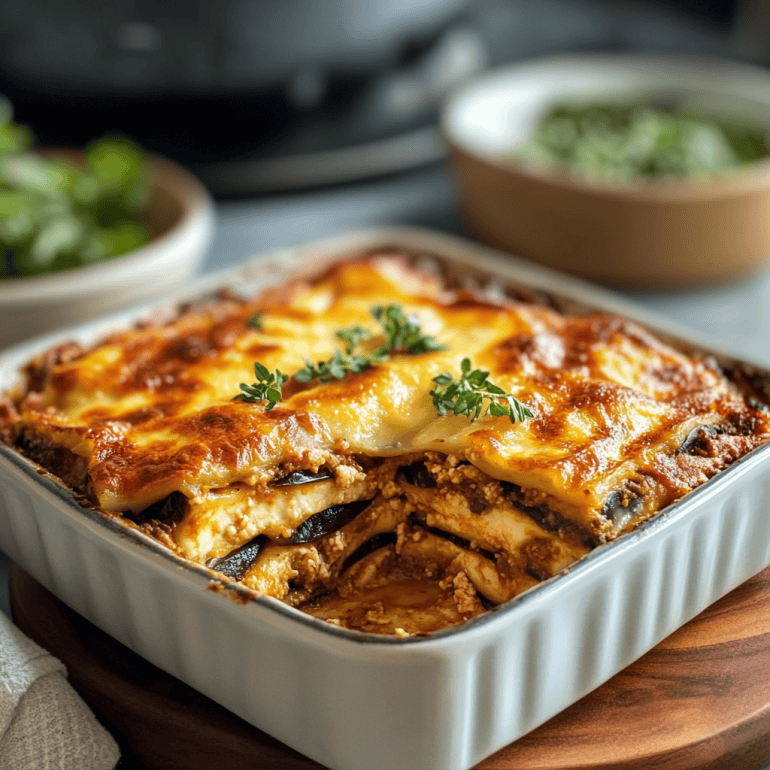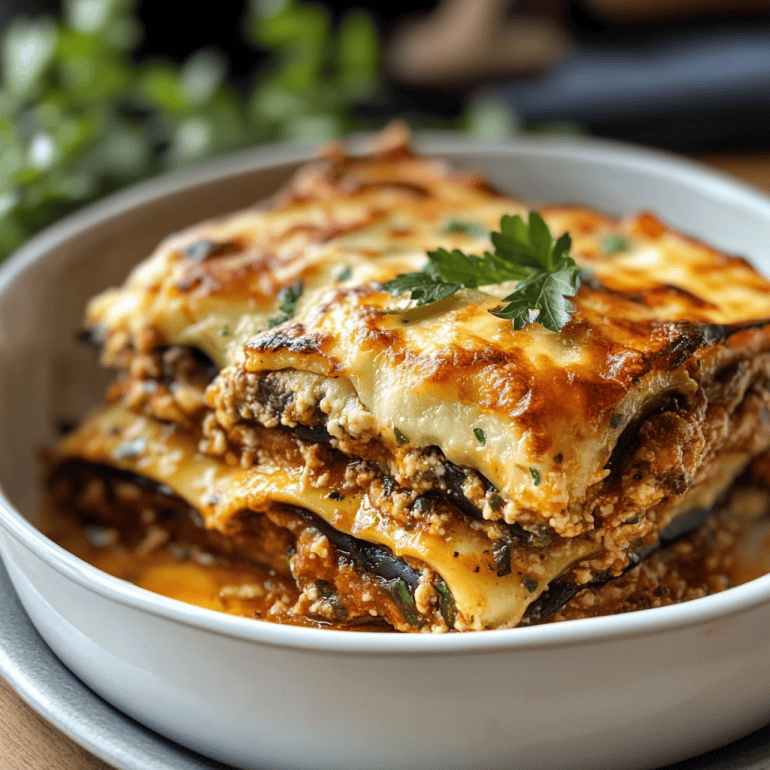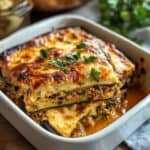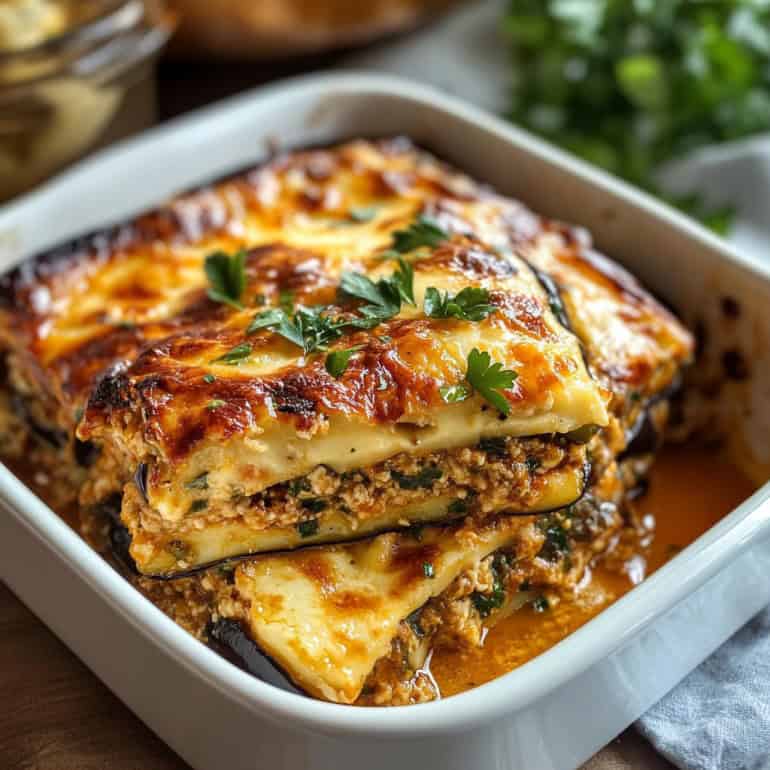Moussaka is a traditional Greek casserole that’s often referred to as Greek Eggplant Lasagna. It features layers of potatoes, oven-roasted eggplant, a flavorful meat filling, and a creamy béchamel sauce, all baked to golden perfection. Whether you’re using eggplant or zucchini, this dish is a must-try for anyone craving authentic Mediterranean comfort food.
Prep Time: 2 hrs 40 mins
Cook Time: 75 mins
Rest Time: 20 mins
Total Time: 4 hrs 15 mins
Servings: 10 to 12 servings
Ingredients
For the Vegetables:
- 3 to 4 eggplants (about 4 pounds)
- Kosher salt, to taste
- 1/3 cup olive oil, divided
- 1 pound potatoes, peeled and boiled in salted water
- 8 large eggs (whites and yolks separated)
- 2 cups plain breadcrumbs, divided
For the Meat Filling:
- 1 1/2 pounds ground beef or lamb
- 2 large onions, finely diced
- 2 cloves garlic, minced
- 1/2 cup dry red wine
- 1 teaspoon ground cinnamon
- 1/4 teaspoon ground allspice
- 1/4 cup fresh parsley, chopped
- 2 tablespoons tomato paste
- 1 cup crushed tomatoes
- 1 teaspoon sugar
- Kosher salt, to taste
- Freshly ground black pepper, to taste
For the Béchamel Sauce:
- 8 ounces (1 cup) unsalted butter
- 1 cup all-purpose flour
- 4 cups milk, warmed
- 1 pinch ground nutmeg
For Topping:
- 1 cup grated kefalotyri cheese, Parmesan, or Pecorino Romano

Instructions
1. Prepare the Vegetables:
- Peel the eggplants partially, leaving 1-inch wide strips of peel. Slice into 1/2-inch slices. Salt the slices liberally and let them brine for 15-20 minutes or up to 1 hour, weighted down with a plate and a heavy object.
- While the eggplants are brining, slice the potatoes into 1/4-inch rounds. Set aside.
- Preheat the oven to 400°F (200°C). Line two baking sheets with foil and lightly grease with olive oil. Rinse and dry the eggplant slices. Dredge them in beaten egg whites and then breadcrumbs. Reserve some breadcrumbs for assembling.
- Bake the eggplant for 30 minutes, turning once, until tender and lightly browned. Set aside and keep the oven on.
2. Make the Meat Filling:
- In a large pan, heat 2 tablespoons of olive oil and brown the ground meat. Add the onions and sauté for 5 minutes until translucent. Add the garlic and cook until fragrant.
- Pour in the wine and let it simmer and reduce slightly. Add cinnamon, allspice, parsley, tomato paste, crushed tomatoes, and sugar. Simmer for 15 minutes until the sauce thickens, stirring occasionally. Season with salt and pepper to taste.
3. Make the Béchamel Sauce:
- In a large saucepan, melt butter over low heat. Whisk in the flour, cooking for 1 minute to form a smooth paste.
- Gradually add warmed milk while whisking continuously. Simmer over low heat until the sauce thickens. Do not let it boil.
- Beat the egg yolks in a small bowl. Remove the sauce from heat and stir in the yolks and a pinch of nutmeg. Return to medium heat and cook for 5-6 minutes, stirring until the sauce thickens. Season with salt.
4. Assemble the Moussaka:
- Lightly grease a large baking dish (lasagna pan works well). Sprinkle the bottom with breadcrumbs.
- Layer the bottom with potato slices, followed by half of the eggplant slices. Add half of the meat sauce, then sprinkle with 1/4 of the grated cheese.
- Add another layer of eggplant slices and top with the remaining 1/4 of the grated cheese.
- Pour the béchamel sauce over the top, spreading it evenly. Sprinkle with the remaining grated cheese.
5. Bake:
- Bake at 400°F (200°C) for 45 minutes, or until the béchamel is golden brown and bubbly. Allow the moussaka to rest for 15-20 minutes before serving.
Zucchini Variation:
For a zucchini alternative, simply slice 4-5 large zucchinis into 1/2-inch slices. Bread and bake them as you would the eggplant. Follow the rest of the recipe as usual. Alternatively, sauté the zucchini slices instead of breading them.
How to Store and Freeze Moussaka:
- Refrigeration: Store cooked leftovers in the fridge for up to 3 days. Reheat at 350°F (175°C) for 30 minutes.
- Freezing: Freeze moussaka before adding béchamel sauce. After thawing, make and pour the béchamel sauce on top before baking. Moussaka can be frozen for up to 3 months.
- Assembling Ahead: Assemble the moussaka (without the béchamel sauce) up to 2 days ahead. Add the béchamel sauce right before baking.

Notes for Classic Greek Eggplant Moussaka:
- Eggplant Preparation: Salting the eggplant slices before baking helps remove excess moisture and bitterness. It’s crucial to rinse and dry the slices after salting to avoid the moussaka becoming soggy.
- Potato Layer: Make sure to slice the potatoes thinly so that they cook evenly. You can use a mandoline slicer to get uniform thickness. The potatoes add a comforting texture and flavor that complements the other ingredients.
- Meat Filling Variations: While traditional moussaka uses ground beef or lamb, you can opt for other ground meats like pork or turkey. For a vegetarian option, you can replace the meat with lentils or a mushroom mixture.
- Wine in Meat Filling: The dry red wine adds depth to the sauce, but if you prefer not to use alcohol, substitute it with a small amount of vegetable broth or water.
- Béchamel Sauce: The egg yolks in the béchamel sauce give it a creamy texture and help thicken it. If you want a lighter version, you can skip the egg yolks, but it will alter the richness of the sauce.
- Zucchini Variation: Zucchini can be a great substitute for eggplant, especially for those who may not enjoy the taste of eggplant. If you’re using zucchini, make sure to slice it thinly and ensure it’s well dried after breading to avoid excess moisture in the dish.
- Freezing and Make-Ahead Tips: Moussaka is a great dish to make in advance and freeze. Assemble the dish (but don’t add the béchamel sauce yet), cover it tightly, and freeze. When ready to bake, thaw it overnight in the fridge, add the béchamel, and bake as directed.
- Grating Cheese: If you’re using kefalotyri cheese, it provides an authentic Greek flavor. However, Parmesan or Pecorino Romano are good substitutes, offering a slightly different taste but still delicious. Make sure to grate the cheese yourself for the best texture and flavor.
- Serving Suggestions: Moussaka pairs beautifully with a Greek salad (like a traditional Horiatiki), tzatziki, and fresh, crusty bread. The dish is hearty and satisfying on its own, so you may not need much else on the side.
Nutrition (per serving):
- Calories: 716
- Fat: 39g
- Carbs: 60g
- Protein: 32g

Classic Greek Eggplant Moussaka
- Prep Time: 2 hrs 40 mins
- Cook Time: 75 mins
- Total Time: 4 hrs 15 mins
- Yield: 10 to 12 servings 1x
Description
Moussaka is a traditional Greek casserole that’s often referred to as Greek Eggplant Lasagna. It features layers of potatoes, oven-roasted eggplant, a flavorful meat filling, and a creamy béchamel sauce, all baked to golden perfection. Whether you’re using eggplant or zucchini, this dish is a must-try for anyone craving authentic Mediterranean comfort food.
Ingredients
For the Vegetables:
-
3 to 4 eggplants (about 4 pounds)
-
Kosher salt, to taste
-
1/3 cup olive oil, divided
-
1 pound potatoes, peeled and boiled in salted water
-
8 large eggs (whites and yolks separated)
-
2 cups plain breadcrumbs, divided
For the Meat Filling:
-
1 1/2 pounds ground beef or lamb
-
2 large onions, finely diced
-
2 cloves garlic, minced
-
1/2 cup dry red wine
-
1 teaspoon ground cinnamon
-
1/4 teaspoon ground allspice
-
1/4 cup fresh parsley, chopped
-
2 tablespoons tomato paste
-
1 cup crushed tomatoes
-
1 teaspoon sugar
-
Kosher salt, to taste
-
Freshly ground black pepper, to taste
For the Béchamel Sauce:
-
8 ounces (1 cup) unsalted butter
-
1 cup all-purpose flour
-
4 cups milk, warmed
-
1 pinch ground nutmeg
For Topping:
-
1 cup grated kefalotyri cheese, Parmesan, or Pecorino Romano
Instructions
1. Prepare the Vegetables:
-
Peel the eggplants partially, leaving 1-inch wide strips of peel. Slice into 1/2-inch slices. Salt the slices liberally and let them brine for 15-20 minutes or up to 1 hour, weighted down with a plate and a heavy object.
-
While the eggplants are brining, slice the potatoes into 1/4-inch rounds. Set aside.
-
Preheat the oven to 400°F (200°C). Line two baking sheets with foil and lightly grease with olive oil. Rinse and dry the eggplant slices. Dredge them in beaten egg whites and then breadcrumbs. Reserve some breadcrumbs for assembling.
-
Bake the eggplant for 30 minutes, turning once, until tender and lightly browned. Set aside and keep the oven on.
2. Make the Meat Filling:
-
In a large pan, heat 2 tablespoons of olive oil and brown the ground meat. Add the onions and sauté for 5 minutes until translucent. Add the garlic and cook until fragrant.
-
Pour in the wine and let it simmer and reduce slightly. Add cinnamon, allspice, parsley, tomato paste, crushed tomatoes, and sugar. Simmer for 15 minutes until the sauce thickens, stirring occasionally. Season with salt and pepper to taste.
3. Make the Béchamel Sauce:
-
In a large saucepan, melt butter over low heat. Whisk in the flour, cooking for 1 minute to form a smooth paste.
-
Gradually add warmed milk while whisking continuously. Simmer over low heat until the sauce thickens. Do not let it boil.
-
Beat the egg yolks in a small bowl. Remove the sauce from heat and stir in the yolks and a pinch of nutmeg. Return to medium heat and cook for 5-6 minutes, stirring until the sauce thickens. Season with salt.
4. Assemble the Moussaka:
-
Lightly grease a large baking dish (lasagna pan works well). Sprinkle the bottom with breadcrumbs.
-
Layer the bottom with potato slices, followed by half of the eggplant slices. Add half of the meat sauce, then sprinkle with 1/4 of the grated cheese.
-
Add another layer of eggplant slices and top with the remaining 1/4 of the grated cheese.
-
Pour the béchamel sauce over the top, spreading it evenly. Sprinkle with the remaining grated cheese.
5. Bake:
-
Bake at 400°F (200°C) for 45 minutes, or until the béchamel is golden brown and bubbly. Allow the moussaka to rest for 15-20 minutes before serving.
Notes
-
Eggplant Preparation: Salting the eggplant slices before baking helps remove excess moisture and bitterness. It’s crucial to rinse and dry the slices after salting to avoid the moussaka becoming soggy.
-
Potato Layer: Make sure to slice the potatoes thinly so that they cook evenly. You can use a mandoline slicer to get uniform thickness. The potatoes add a comforting texture and flavor that complements the other ingredients.
-
Meat Filling Variations: While traditional moussaka uses ground beef or lamb, you can opt for other ground meats like pork or turkey. For a vegetarian option, you can replace the meat with lentils or a mushroom mixture.
-
Wine in Meat Filling: The dry red wine adds depth to the sauce, but if you prefer not to use alcohol, substitute it with a small amount of vegetable broth or water.
-
Béchamel Sauce: The egg yolks in the béchamel sauce give it a creamy texture and help thicken it. If you want a lighter version, you can skip the egg yolks, but it will alter the richness of the sauce.
-
Zucchini Variation: Zucchini can be a great substitute for eggplant, especially for those who may not enjoy the taste of eggplant. If you’re using zucchini, make sure to slice it thinly and ensure it’s well dried after breading to avoid excess moisture in the dish.
-
Freezing and Make-Ahead Tips: Moussaka is a great dish to make in advance and freeze. Assemble the dish (but don’t add the béchamel sauce yet), cover it tightly, and freeze. When ready to bake, thaw it overnight in the fridge, add the béchamel, and bake as directed.
-
Grating Cheese: If you’re using kefalotyri cheese, it provides an authentic Greek flavor. However, Parmesan or Pecorino Romano are good substitutes, offering a slightly different taste but still delicious. Make sure to grate the cheese yourself for the best texture and flavor.
-
Serving Suggestions: Moussaka pairs beautifully with a Greek salad (like a traditional Horiatiki), tzatziki, and fresh, crusty bread. The dish is hearty and satisfying on its own, so you may not need much else on the side.

